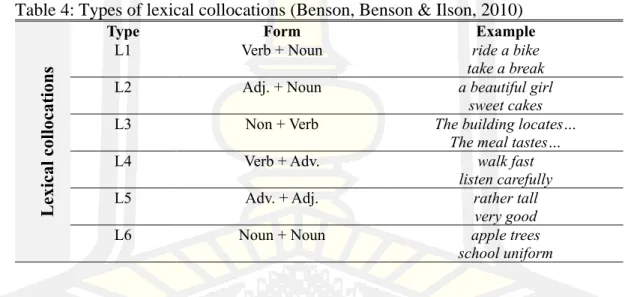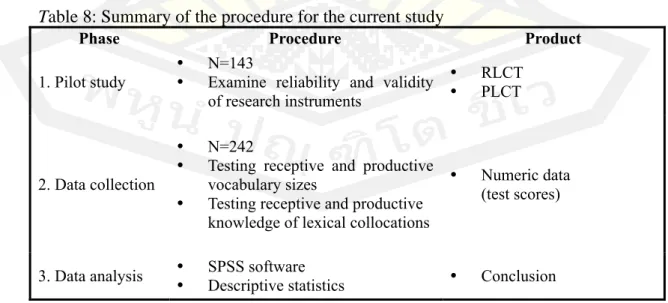The relationship between Thai University learners' vocabulary sizes and their receptive and productive knowledge of lexical compounds. TITLE The relationship between Thai University learners' vocabulary sizes and their receptive and productive knowledge of lexical compounds.

INTRODUCTION
- Purposes of the research
- Scope of the research
- Significance of the study
- Definition of the key terms
- Organization of the study
What is the relationship between Thai university EFL learners' vocabulary sizes and their receptive and productive knowledge of lexical collocations. The study examines the relationship between Thai university students' vocabulary sizes and their receptive and productive lexical collocations.
LITERATURE REVIEW
Vocabulary knowledge
- Knowing a word
Richards (1976) first proposed a descriptive framework of vocabulary knowledge that is considered one of the most fundamental and influential definitions of vocabulary knowledge. Therefore, Nation (2013) offered a deeper interpretation of different aspects of word recognition through receptive and productive knowledge.
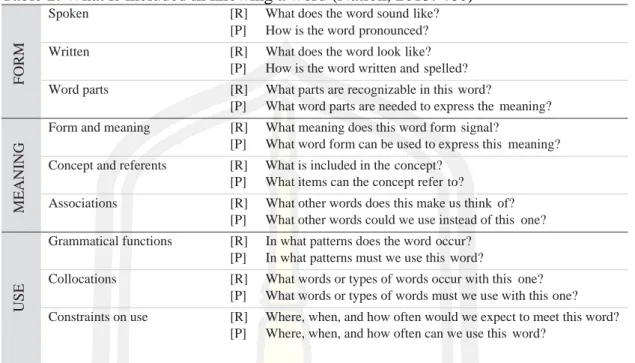
Collocational knowledge
- Knowing collocations
- The roles of collocations in vocabulary acquisition
Benson, Benson & Ilson (2010) provided a clear definition of collocation in the introduction to the BBI Combinatory Dictionary of English, defining collocations as. Furthermore, McCarthy (2017a) noted that “collocation is very important in vocabulary teaching, the collocation relationship is fundamental to vocabulary study, and collocation is an important organizing principle in the vocabulary of any language” (McCarthy, 2017a).
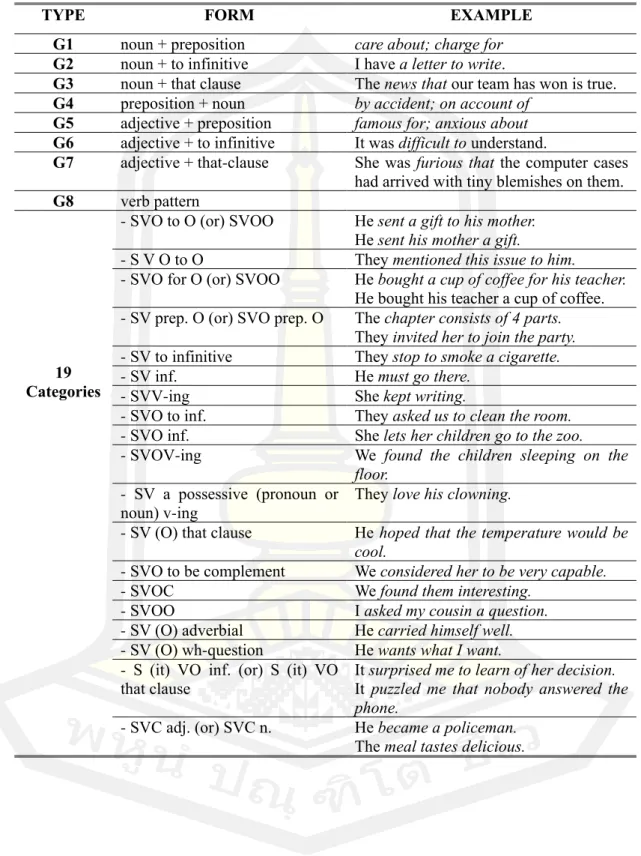
Vocabulary assessment
- Assessing receptive vocabulary knowledge
- Assessing productive vocabulary knowledge
- Assessing receptive knowledge of English collocations
- Assessing productive knowledge of English collocations
The four related words were selected to represent three main types of semantic relationships with the target word: paradigmatic relationships (i.e., the word and its companion have similar meanings, e.g., enable and allow); syntagmatic relations (ie, the two words are shared and occur in similar contexts, such as income and taxes); and analytic relations (ie, association represents the meaning of a part of speech, such as team and together). Test takers are asked to choose the correct and appropriate words from the three columns to the right of the table to complete the sentence.
Previous studies on vocabulary in the EFL context
The objective of the study was to use a group of English-Thai bilinguals Vocabulary Size Test (VST) to assess their vocabulary size and examine the relationship between vocabulary size and years of study. In a similar research background, Pringprom & Obchuae (2011) studied the relationship between vocabulary size and reading comprehension. Additionally, Nirattisai and Chiramanee (2014) studied the relationship between vocabulary learning strategies and vocabulary size among 257 Thai university students from six different majors using two tools: vocabulary learning strategies.
The extent to which participants used strategies for general vocabulary learning was related to their vocabulary size.
Previous studies on collocations in the EFL context
The results of the study showed a slight difference between the receptive and productive collocational knowledge of advanced EFL learners, while it is intermediate. Two measures were given to participants to measure their receptive and productive knowledge of lexical collocations. The results showed that Thai university learners significantly improved receptive knowledge of lexical collocations than productive knowledge.
The results showed that the participants' receptive and productive knowledge of collocations was at a low level.
Summary of the chapter
Rakpa (2021) investigated the collocation competence of 34 Thai English major university fourth-year students, classified the type of grammatical collocation and lexical collocation that is the most problematic, and explored the strategy used to deal with collocation difficulties. Four tests were used in this study to assess students' vocabulary knowledge, two of which were designed specifically for this study based on previous research. Vocabulary sizes were captured by adopting two tests, New Vocabulary Levels Test (NVLT) and Word Associates Test (WAT), which are validated by Schmitt &.
Receptive and productive knowledge of lexical collocations was measured using two new tests, the Receptive Lexical Collocations Test (RLCT) and the Productive Lexical Collocations Test (PLCT), which were developed for this study based on Brashi (2009) and Laufer & Nation (1999).
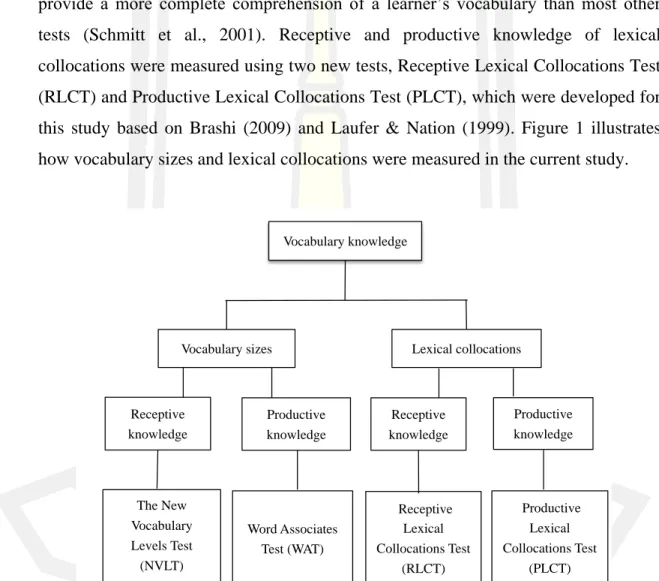
RESEARCH METHODS
- Research design and approach
- Participants and setting
- Research instruments
- The New Vocabulary Levels Test (NVLT)
- Word Associates Test (WAT)
- Receptive Lexical Collocations Test (RLCT)
- Productive Lexical Collocations Test (PLCT)
- Selected target lexical collocations for the current study
- Data collection procedure
- Data analysis
- Summary
This chapter presents findings regarding Thai university students' receptive and productive knowledge of vocabulary sizes and lexical collocations. This section answers research question 2: What is the receptive and productive knowledge of lexical collocations of Thai university students. Figure 4 shows a summary of the general receptive and productive knowledge of lexical collocations for Thai university students.
This shows that college students' vocabulary size develops based on their receptive and productive knowledge of lexical collocations.
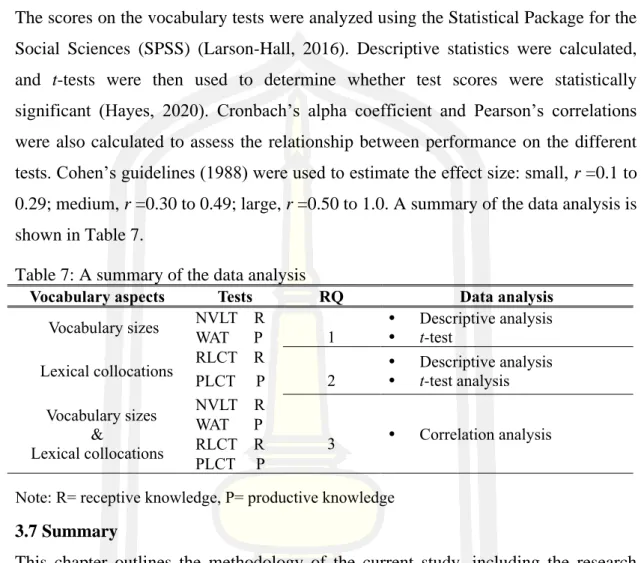
PILOT STUDY RESULTS
Results of the pilot study
Two measures of receptive and productive knowledge of lexical collocations, the Receptive Lexical Collocations Test (RLCT) and the Productive Lexical Collocations Test (PLCT), were pilot tested with 143 Thai university students, including first- and fourth-year participants at a public university in Northeast Thailand. The results showed that the participants achieved receptive lexical collocations significantly better than productive lexical collocations. A comparison between the performance of first and fourth year participants in lexical collocations is shown in Table 10.
A summary of general receptive and productive knowledge of lexical collocations among Thai university students is shown in Figure 2.
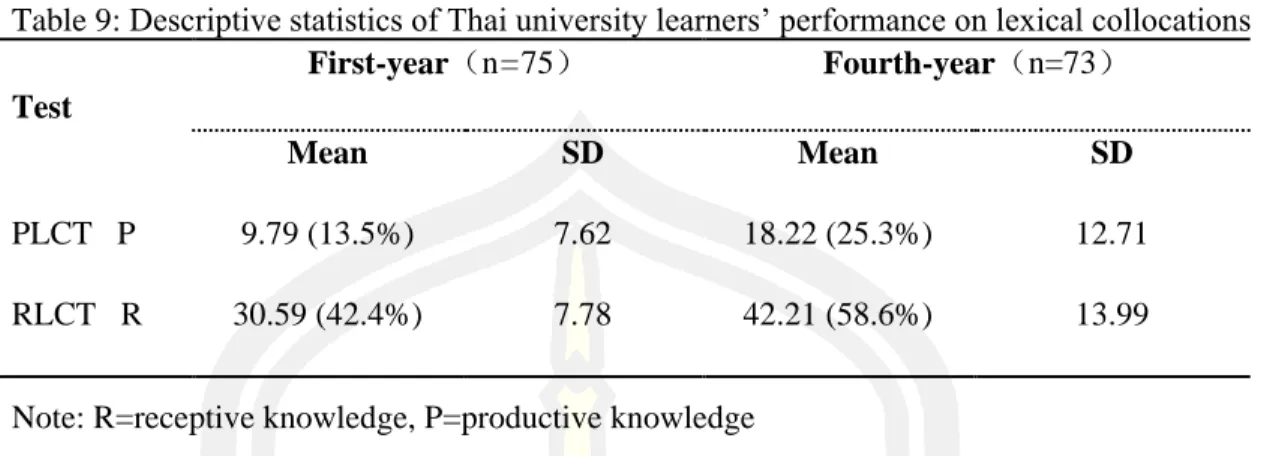
Validation of the tests
Specifically, all lexical collocations were checked on the website to judge whether the target lexical collocations were correct. Items that were not selected from the Corpus of Contemporary American English (COCA) and the British National Corpus (BNC) were also excluded. Specifically, the promoted lexical items were modified and the content of each test was typically appropriate for a Thai EFL context.
After all, 18 lexical collocations were removed and modified for each test, resulting in 54 target lexical collocations for each test, both receptive and productive.
Summary of the Chapter
An overview of the descriptive statistics of Thai university students' receptive and productive knowledge of vocabulary sizes is presented in Table 11. The comparison of Thai university students' receptive and productive knowledge of vocabulary sizes is shown in Table 14. Specifically, the New Vocabulary Levels Test (NVLT) that measures receptive knowledge of vocabulary sizes, received the highest mean performance followed by the Word Associates Test (WAT), which measured productive knowledge of vocabulary sizes.
The correlation analysis also revealed that receptive and productive knowledge of vocabulary sizes and lexical collocations are positively related.
MAIN STUDY RESULTS
Thai EFL university learners’ receptive and productive knowledge of
Receptive and productive tests were used to examine overall receptive and productive knowledge of vocabulary size in first- and fourth-year Thai university students. The New Vocabulary Levels Test (NVLT) measured participants' receptive knowledge of vocabulary size, while the Word Associates Test (WAT) measured productive knowledge of vocabulary size. The comparison between receptive and productive vocabulary size knowledge of first- and fourth-year university students is illustrated in Table 12.
A summary of the average performance on the receptive and productive knowledge of vocabulary sizes on two tests, the New Vocabulary Levels Test and the Word Associates Test, is illustrated in Figure 3.
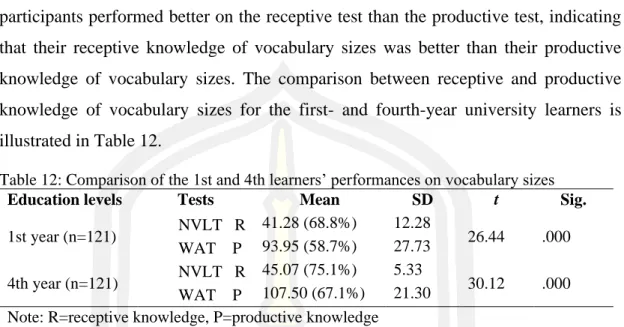
Thai EFL university learners’ receptive and productive knowledge of lexical
This suggests that productive knowledge of lexical collocations is more difficult to acquire than receptive knowledge of lexical collocations. The results found that the first-year participants' performance was lower than the fourth-year participants' knowledge of lexical collocations. In general, the results showed that participants in both the first year and the fourth year have higher performance on the receptive knowledge of lexical collocations.
This suggests that receptive knowledge of lexical collocations is easier to acquire than productive knowledge of lexical collocations.

Relationship between receptive and productive knowledge of vocabulary sizes
There was also a moderate positive correlation between the Receptive Lexical Collocations Test (RLCT) and the Productive Lexical Collocations Test (PLCT), which measure receptive and productive knowledge of lexical collocations (r = .175). That is, there was a moderate correlation between performance on the New Vocabulary Levels Test (NVLT), a measure of receptive knowledge of vocabulary sizes, and the Receptive Lexical Collocations Test (RLCT), a measure of receptive knowledge of lexical collocations (r = .258). Furthermore, there was a moderate correlation between the Word Associates Test (WAT), a measure of receptive knowledge of vocabulary sizes, and the Receptive Lexical Collocations Test (RLCT), a measure of receptive knowledge of lexical collocations (r = 0.178).
This indicates that an increase in knowledge of (and number of) lexical items is associated with an increase in knowledge of vocabulary sizes.

Summary of the chapter
Interestingly, both fourth-year and first-year university students performed better on receptive knowledge of vocabulary size than on productive knowledge. Importantly, the receptive knowledge of English collocations is a scaffolding mechanism for the productive knowledge of collocations. Furthermore, Thai university students' receptive and productive knowledge of lexical collocations were found to be significantly correlated with their vocabulary size.
Additionally, this study assessed knowledge of vocabulary sizes and lexical collocations among English majors.
DISCUSSION AND CONCLUSION
Thai EFL university learners’ receptive and productive knowledge of
The analyzes of the findings revealed that receptive knowledge of vocabulary size was better than productive knowledge among the Thai university participants. Furthermore, fourth-year students performed better than first-year students on both receptive and productive tests of vocabulary size. Together, the current findings revealed the acquisition sequence of vocabulary knowledge in Thai university students.
The current results also revealed that fourth-year college students performed significantly better on receptive and productive knowledge of vocabulary sizes than first-year college students on the two tests.
Thai EFL university learners’ receptive and productive knowledge of lexical
That is, the productive measure of collocational knowledge may have imposed a much greater processing demand on Thai university learners than the receptive measure. This distinction between the performance of the RLCT and PLCT measures may suggest that the receptive collocation knowledge task acts as a scaffold for the development of productive collocation knowledge. That is, the productive collocation recognition task may have imposed a heavier cognitive process on Thai university participants than the receptive collocation recognition task.
The distinctive gap between the performance of productive and receptive knowledge tasks may imply that the receptive collective knowledge task acts as a scaffolding block for the development of collective lexical knowledge, thereby increasing Thai EFL learners' knowledge of collocations.
Relationship between receptive and productive knowledge of vocabulary sizes
The current study provides empirical evidence to support previous studies that students' knowledge of collocations develops as they move from one learning level to another (e.g., Diao, 2004; Koya, 2003; Wu, 2005). Previous studies have also reported a positive relationship between receptive knowledge and productive knowledge of English collocations (Detdamrongpreecha, 2014; Begagić, 2014; Chorbwhan & McLellan, 2016). However, Al-Amro (2006) found that students were more accurate in productive knowledge of collocations than in receptive knowledge, but this was likely "because the collocations included in the receptive test were less frequent than other collocations in the productive test" (Al -Amro, 2006).
The study's data analysis indicates that students with larger vocabularies tend to have higher knowledge of collocations than their counterparts.
Conclusion of the study
In summary, vocabulary knowledge requires different aspects of comprehensive knowledge of a word, and this suggests that different interrelated knowledge of a word is needed to improve vocabulary learnability. Multiple closely related aspects of word knowledge positively influence L2 or EFL learners in the development of vocabulary learning.
Implications for vocabulary learning
- Methodological contribution
- Pedagogical contribution
Based on the findings, some pedagogical implications are provided that will be useful for practitioners, teachers, and test developers regarding vocabulary size and knowledge of lexical collocations. Although participants' vocabulary size and lexical collocation knowledge were found to develop along with their education and proficiency levels, participants did not have adequate knowledge of vocabulary size and lexical collocations. Importantly, teachers should not consider vocabulary size as the sole standard for assessing students' overall vocabulary knowledge.
Overall, vocabulary sizes and collocation knowledge benefit university students' vocabulary acquisition, especially in the Thai EFL teaching context.
Limitations of the current study
For example, if a teacher is teaching heavy, in addition to explaining heavy, heavier, and heaviest, other important vocabulary combinations should be explained such as heavy rain, heavy smoker, heavy drinker, heavy traffic, and other important collocations.
Recommendations for future studies
Features of Lexical Collocations in L2 Writing: A Case of Korean Adult Learners of English. Teaching English. An investigation of Thai 12th grade students' English reading problems in Nakhonratchasima Education Regions 1,2,3 and 7. Master's Thesis, Srinakharinwirot University, Srinakharinwirot, Thailand. Interpreting vocabulary test scores: what different item formats tell us about students' ability to use words.
An investigation into the vocabulary size of Thai first-year college students and its relationship to years of English study. A survey and investigation of the collocational ability of high school students' English vocabulary. L1 Influence on advanced ESL/EFL Arabic learners' reception and production of collocations of English.

